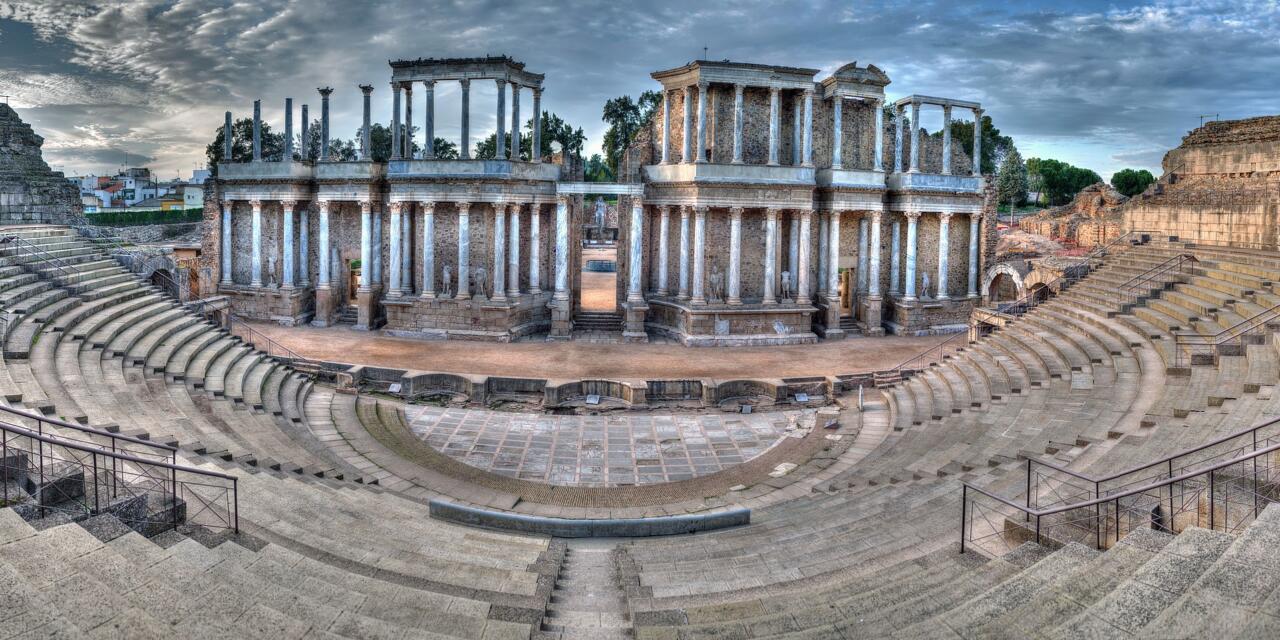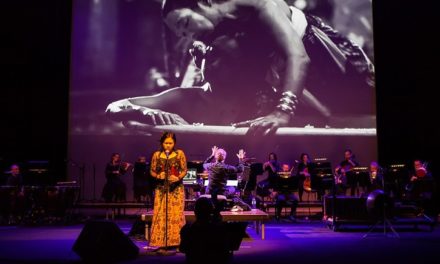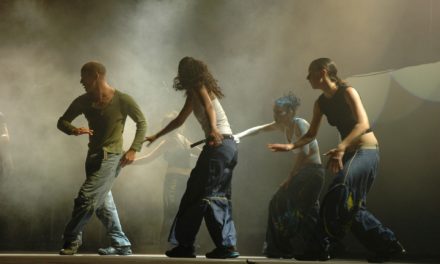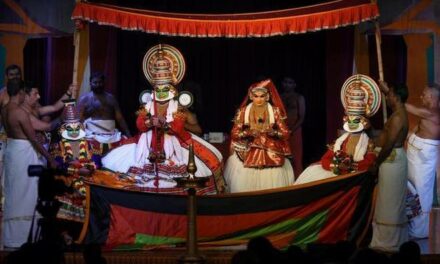
Photograph by Javier Naval
Jesús Cimarro is the current President of the Spanish Academy of Performing Arts (Academia de las Artes Escénicas de España), as well as the co-founder and director of the theatrical production and distribution company Pentación Espectáculos. On the occasion of the upcoming celebration of the International Online Theatre Festival, he welcomes me to his office to talk about the topic of “theatre and its others” in connection to the spaces he directs and manages.
Natalia García-Casarrubios: During the months of July and August, the community of Extremadura becomes one of the most important cultural hotspots in Spain due to the celebration of the International Classical Theatre Festival of Mérida. This translates into economic benefits for the community linked to tourism, but beyond this, as a director, you have always been committed to ensuring that Extremadura’s theatrical fabric is well-represented and boosted by this event. What can you tell us about this decision?
Jesús Cimarro: Yes, since I assumed the direction of the Festival in 2012 I made it so that the official Roman theatre [the main venue] program necessarily includes two shows by companies from Extremadura co-produced by the Festival. This has happened in the eleven editions that I have been directing and again in the one we are going to present in March and that will take place in July and August this year. Moreover, all the side events are carried out by Extremadura companies: the parades, the activities for families, and the twenty theatre workshops held in twenty different municipalities of Extremadura. That is to say, in each edition, there is an average of between twenty-six and twenty-eight companies featured. Evidently, this shows the interest we [the management] have in the presence of local and regional productions across the whole program.
In addition, the co-produced shows are present in the programming of the Festival’s extensions in Medellín, Cáparra, Regina, and Madrid the following year. This cultural policy has shown that the Festival serves as a platform for Extremadura companies to showcase their work and meet programmers and artistic directors. In fact, many of them go on to perform at various venues and festivals in subsequent years.
NG: Speaking of the productions themselves and the preparation of the program, how important is it for the Festival’s management that the proposals, while based on classical texts, appeal to a 21st-century audience and address current issues?
JC: The festival has a Greco-Latin and Greco-Roman theme, so the number of titles available is not very large. To avoid repetition, what I propose are collaborations with contemporary playwrights to write about characters and myths from Greek and Roman times. In this way, texts are adapted and written with the main idea that the classic has a contemporary look, a contemporary reading, and a contemporary language that also reaches the younger generations because otherwise, it would be very difficult. Clear examples of this in the last edition are Safo [a hybrid theatre production created, directed, and performed by a team of female artists and described as a scenic, musical, and visual poem that explores the figure of the great poet of Lesbos]; or the Oedipus written by Paco Becerra, a different take on the classic starring a cast of young actors and actresses.
I also really like the mix of different styles. Sometimes we get it right and sometimes we don’t, of course, but we try to make this blend as rich as possible in order to cover a wide range of programming for all tastes.
NC: So it can also be said that this contemporary vision opens the door to artists who otherwise might not be as widely represented in classical productions.
JC: Exactly.
NC: Going back to the audience, I understand that this aim for the productions to reach as many people as possible also involves the implementation of initiatives that improve accessibility for functionally diverse spectators. Is this the case?
JC: Yes, there is practically universal accessibility at the festival: we work with different organizations to guarantee accessibility through the magnetic loop, audio description, subtitling, vibrating backpacks, or touch tours prior to the performance in order to eliminate possible barriers of access to the shows. And we also try to eliminate these barriers in the productions themselves, for example with the inclusive opera we did in 2019, [Sansón y Dalila] where there was a chorus composed of people with intellectual diversity. And the same in Pentación’s venues. We try to make all the spaces as accessible as possible for the public and the artists.
NC: Pentacion Espectáculos is the company that manages the Festival, but it also has three other branches in Madrid: Teatro de La Latina, Teatro Reina Victoria, and Teatro Bellas Artes. Do you think of these venues as “the other” of each branch? Or how are Pentación’s artistic goals distributed along the programming of each theatre?
JC: I do try to ensure that each venue has its own distinctive characteristics, and within this, that the program is as coherent as possible: in the Bellas Artes we mainly do titles from the repertoire of the XX-XXI century; in the Reina Victoria we try to have a more eclectic program, with a variety of styles; and in La Latina due to its features (it is a large theatre, with 900 seats) we try to have medium and large format shows, oftentimes musicals or comedy shows, but not only. On this occasion, we have, for example, the musical play Los chicos del coro [The Chorus].
NC: All three venues have been a part of Madrid’s theatre scene for decades. As a director, do you try to incorporate a small allusion to the previous history of each space in the programming lines?
JC: Obviously you can’t always preserve the genres of a century ago: for instance, La Latina is a hundred and four years old and it was famous for offering revue shows, but we do preserve the essence. And in a broader sense, the essence is that we are dedicated to making theatre for all audiences. Improving quality, improving accessibility, improving so that the public feels as comfortable as possible when they enter, as I say, these temples of culture.
NC: And how significant do you believe it is to regard children as the future audiences when programming theatre for kids?
JC: Very. In fact, at the Bellas Artes Theatre we work with the company Ópera Divertidísima, a group that creates family shows so that children can be introduced to the world of opera from an educational and entertaining point of view. And we apply this same idea to other venues, depending on the proposals we get.
NC: The Spanish Academy of Performing Arts generates and promotes several activities that put the younger generations of stage professionals in conversation with consecrated practitioners. Is this also an effort to connect different generations and provide opportunities for the upcoming talent in the performing arts to advance their careers?
JC: I have presided over the Academy for four years and before that, I was vice president. I have been, so to speak, for almost eight years in management positions, and especially in the last four as president, I was very clear, together with my board of directors, that the Academy of Performing Arts had to promote excellence above all: not to turn into a stagnant environment where there is no room for progress but to break down those barriers — for young people to know what great figures, both known and unknown, have done in this country.
Memory is fundamental and in theatre and the performing arts it is key, because one learns from one’s elders, from what they tell you, and from experiences. That is why we made the documentary Empuñando el alma [about the work of the stage director and Honorary Academician Lluís Pascual]; or the documentary we made featuring Lola Herrera about the experience of an actress who has been on the stage for sixty years. I believe it was fundamental that she told her story and that it did not get lost: the Academy aims, among other goals to safeguard memory so that it can nourish the upcoming generations of professionals.
And then specifically for young professionals, there are different activities to promote studies and rigorous research, such as the José Monleón prize [aimed at young researchers and end-of-degree projects in the Performing Arts field]. Another activity is the publication of books: For example, there was no publication on the history of contemporary dance in Spain. There was no documentation. At last, the Academy published three very interesting volumes that are useful for any scholar and for anyone in the profession to know what has been done in the past century and to be able to continue building on this knowledge.
NC: To finish I wanted to ask you: What is your perspective on the significance of achieving a balance between the artistic and economic aspects of management, and how do you approach this in your work?
JC: Let’s see, usually economic management and artistic direction are two separate positions, but in my case, I hold both because I have always defended that you have to have a certain sensitivity from the production side to work with the artistic side. I believe that if you don’t have that awareness it is very difficult not to see and treat the artist and his or her needs as “the other”. And vice versa, I think that artists must understand the world of production. I think, and it may sound bold for me to say it, I think that the International Classical Theatre Festival of Mérida is proof that this combination is positive at all levels.
NC: Because it allows for the generation and application of cultural policies such as those discussed at the beginning of the interview.
JC: Yes, we have set up a model that I think is not very common in Spain: a mixed model based on having a festival that is public, but with private management. I think it would be good to explore it further because it has worked very well to achieve the balance we are talking about.
This post was written by the author in their personal capacity.The opinions expressed in this article are the author’s own and do not reflect the view of The Theatre Times, their staff or collaborators.
This post was written by Natalia García-Casarrubios.
The views expressed here belong to the author and do not necessarily reflect our views and opinions.


















